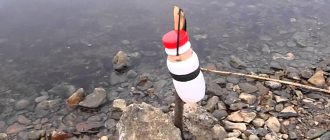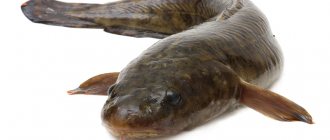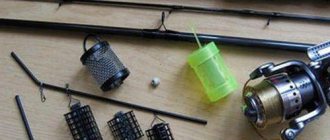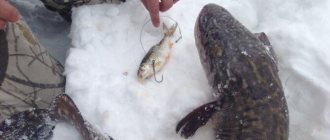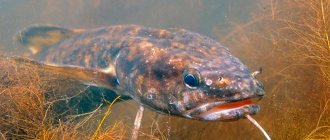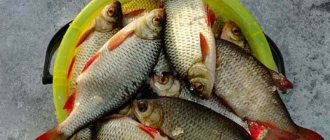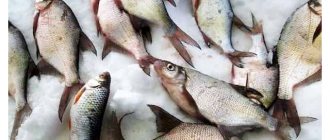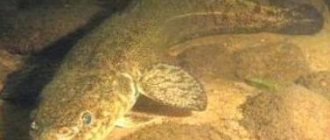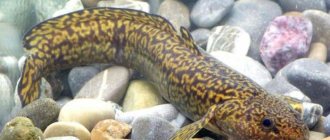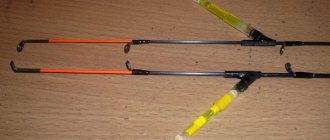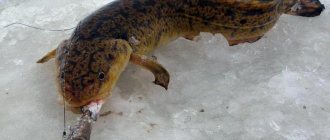The freshwater representative of cod prefers places of residence with clean water at low temperatures. You should not look for burbot in reservoirs with silted bottoms; they will rather choose areas with slow flows. And spring jets can attract several individuals at once. Burbot is a nocturnal predator that looks a little like a catfish. The diet of these two fish is almost identical; they are considered orderlies of reservoirs. But the maximum activity of catfish occurs in the summer months, when the water has warmed up. Burbot hibernates in the summer and becomes active only with the first frost, when the water temperature drops to +6. Representatives of cod fish spawn in winter. And, interestingly, the stronger the frost, the more active spawning occurs. Fishing for burbot will be successful only in the dark. Its capture is possible on a moonless stormy night in autumn, winter and early spring, while the water in the reservoir is cool. In winter, after freeze-up, sexually mature burbot begins to move upstream to spawn. It will be a great success to find such a burbot trail. Here you can catch a real giant. It is popular to catch burbot at night using bait baits loaded with live bait. It is ice fishing for burbot that is especially popular among fishermen. Having become hungry during the summer, this nocturnal predator begins to actively feed and grabs almost any bait offered to it.
Search Locations
In winter, burbot returns to its former places in search of food. The territory chosen in the spring is checked in the fall, and completely controlled in the winter. Mostly these are bottom and near-bottom areas on a river or lake, where ruffs are necessarily found. It is the presence of this small fish in the reservoir that will confirm the guess as to whether this predator lives here. Experienced fishermen who specialize specifically in catching burbot in rivers advise choosing the following fishing places: • river mouth; • stone ridges; • stuck holes; • near trees that have fallen into the water; • at the border of the current and the whirlpool.
In winter, you should wait for lake burbot in places with underground springs or on shallows with a sandy bottom covering. It is not by chance that burbot chooses such places; as the temperature drops, the inhabitants of water spaces become less active and choose quiet, secluded places for themselves. This is exactly what this representative of cod fish uses. But promising places are not always the key to successful fishing; sometimes it takes several days to find this fish. But after this the trophy becomes even more attractive. Towards the end of winter, burbot becomes more active; it is during this period that even a novice fisherman will be lucky with his catch.
Types of tackle
There are several options for snitching, which are widely used by domestic fishermen when fishing for burbot:
- classical;
- jig;
- Finnish.
All options are working. With a meaningful approach, they show stable results.
Classic snitch
A common bait is in the shape of a cone, cylinder or oval. Hooks are rigidly soldered on one or both sides. The loop for attaching to the fishing line is located in the back, and one or more tees can be suspended in the belly.
The simplest classic knocker is often made from a cartridge case. To do this, the capsule part is sawed off, shot is poured inside, and the outside is sealed or filled with lead. All that remains is to equip the bait with sharp and reliable hooks.
Squealing jig
For this option, any heavy jig that can be used in a given place is suitable. Its weight varies between 10–40 grams. It is selected so that the hook quickly reaches the bottom, does not leave the fishing horizon, and does not hang up after being tossed.
Under the same fishing conditions, the weight of a classic jig will be higher than a jig head due to its windage.
A banal jig head is the simplest version of jigging a jig. You can use a regular spherical shape, but it is better to choose a conical or oblong one. An interesting modification is a weight with a petal freely suspended on a swivel.
Recommended reading: Catching bream with a ring from a boat
Finnish snitch
This option is a modified heavy oscillating spoon. A lead load is additionally soldered in its lower part, designed to shift the center of gravity of the bait and increase its noise effect.
The Finnish patter can be made from any vibrator. It is impossible to predict in advance the catchability of the bait. Only by trial and error on a pond will a fisherman be able to determine the performance characteristics of the modified “hardware”, further adjusting it if necessary.
Tackle for catching burbot in winter
Fishing for burbot in winter is carried out from a solid ice cover of the reservoir. This can be done in three ways: • Using a spoon. • On the girders. • For a winter fishing rod with a jig. The gear used is quite rough. Don’t be afraid to use a thick fishing line, this will help to hold and remove this predator from the hole. And the equipment itself for burbot will not be noticeable in winter, since when searching for food it uses the organs of touch and smell. His vision is poorly developed. The hooks used are also not small, from 8 to 12 sizes. Advice! To rig bait stations for live bait, use high-quality single hooks with notches. This will allow you to hold and retrieve even large fish. The rod itself must be of high quality, maximum 40 cm long. It is desirable that the handle be made of foam or neoprene. The whip is elastic, but not very hard. For winter fishing rods, a fishing line with a thickness of at least 0.3 mm is usually used. But it can be replaced with a high-quality braided cord with a breaking load of 8 kg. When collecting gear for catching burbot at night, do not forget about the loads. To rig fishing rods, you need to use heavy weights that will quickly sink to the bottom and will not allow the fish to easily pull the hook into the snag. Leashes are used no longer than 20 cm, with a slightly lower breaking load than the main fishing line or thread. They need to be knitted no closer than 15 cm from the load, in order to avoid overlap. Advice! When collecting bottom tackle for catching burbot at night, it is advisable to use two sinkers. The first is firmly attached to the end of the fishing line. The second one descends along it after throwing the tackle. This will allow the bait to rise from the bottom, but will not allow it to roll far.
Catching large burbot using a line
When fishing for a predator, the angler can use several gears at once with different throwing distances. There is also a prospect for maximum coverage of catchable areas of the reservoir. Catching large burbot using a line has some differences.
To catch fish, you can bait the hooks with:
- Fish fillet (with skin)
- Bunch of worms
- Sliced spleen (from 2x2 cm to 5 cm)
- Whitebait (roach, crucian carp, silver bream, gudgeon, etc.)
Fishermen have noticed that large specimens bite well on fry only during the feeding season. During other periods they are caught using worms and other baits. Since this fish is both a predator and a scavenger, you can attach small frogs, store-bought sprat and even pieces of herring.
There are no strict recommendations for catching big fish. But you need to know the exact period when gluttony appears in burbot. Typically, this time starts from December, covering January. In winter, it is difficult for fish to get food, and they are forced to be active. The best areas for fishing are located in areas where there are rubble and snags. During the cold season, there is a high probability of catching large specimens.
Spoons
A very popular method among fishermen is the method of catching burbot in winter using spoons. They come in different shapes and colors. But the so-called “snitch” is considered the most catchy. This spoon is a rounded weight with hooks on the sides. It comes in different shapes and weights. At the same time, the size of the caught fish does not depend in any way on the size of the spoon. You need to choose according to the place of intended fishing: the deeper, the larger the spoon. This bait does not require any special game. A simple tap on the bottom is enough for the fisherman. To do this, he slowly raises the fishing rod not high above the hole, and then sharply lowers it. This creates a dull sound and raises a small amount of turbidity, which the predator will follow. In addition, he will be attracted by the smell of bait on the hooks. “Balls” are also not inferior in catchability. This type of spoon is designed to catch larger individuals of this species. You can make it yourself. To do this you will need: • three sliding round weights; • small bolts. To begin with, you need to not completely screw the bolts into the sinkers. At the same time, we make sure that the hole remains intact. We collect them on a fishing line, and attach a large treble hook a little higher. The spinner is ready. Additionally, you can put bait on the hook. The game of this spinner is identical to that of a “snitch”. However, due to the bolts, additional noise will be created, which is attractive for this type of cod.
How to set the line correctly?
There are three ways to install a net, but only bottom fishing is suitable for winter fishing.
The fisherman himself chooses the optimal place where the hunting routes of burbot pass, which, as is known, does not change its habits.
For ice fishing, holes are drilled at a distance of 5-8 m from each other.
The distance is chosen based on the length of the run (a stick that is launched under the ice) or a special wire hook.
The fisherman attaches the line itself directly to it, sequentially putting bait on the hooks as it is immersed in the water, and the run seems to “stretch” under the ice from hole to hole.
It is recommended to go fishing in winter with a group. While one fisherman lowers the line under the ice, the second puts on live bait. Then the tackle will not get tangled.
After the line is installed, it is slightly pulled up to evenly place the gear on the bottom.
The optimal time for installing a hook net for burbot is considered to be the period from 21:00 to 2:00-3:00. The catch should be checked early in the morning.
installation of a crossing on the current
Zherlitsy
Probably the easiest way to catch burbot is with girders. Usually they are installed in the evening, and in the morning they check the gear and take the catch. To equip the girder, a fishing line with a cross section of 0.45-0.5 mm is used. Its quantity on the reel depends on the depth of the reservoir. Advice! You should not wind a lot of fishing line on the reel of the fishing rod. This will not allow the fish to go into snags or stones. A sufficient length is equal to the depth of the place being fished plus 1 m. The leash is set with a thickness of 0.25-0.28 mm. It is advisable to tie it to the main line through a swivel to avoid tangling of the equipment. A triple or double live bait hook, at least size 10, is placed at the end of the leash. Advice! It is better to take leashes for girders from durable materials, such as steel or braided cord. It is these that will be difficult for burbot to snack on. A sliding sinker weighing up to 15 grams is attached in front of the leash. Small live bait is used as bait for girders. It should be baited behind the back, so it will remain mobile longer and will be able to attract more fish. To remove trophy specimens from the hole, every fisherman needs to have a hook in his arsenal.
Sinker for winter donkey
The choice of sinker for bottom tackle for burbot is a very important point. The main requirement is that the weight presses the equipment to the bottom, and after the bite the fish is caught due to its weight. But a heavy load reduces the sensitivity of the tackle and therefore you need to select a sinker that, on the one hand, will allow the fish to be hooked, but, on the other hand, will not be too heavy.
The shape of the selected sinker depends on the type of bottom in the reservoir and the presence of current. A flat load is less noticeable and has a larger area of adhesion to the bottom. In addition, when falling to the bottom, the flat sinker makes a sound that attracts burbot to the bait. But when pulling a flat weight along the bottom, it clings to obstacles and on a cluttered bottom it is better to use sinkers in the shape of an olive or a ball.
Homemade weights made from an aluminum spoon are the optimal choice for catching burbot both in shape and weight. The fall of such a sinker onto a hard bottom is accompanied by a “knock”, which attracts the attention of fish located not far from the fishing point.
When fishing with live bait, the weight of the sinker should be enough to hold the equipment in one place, and it does not float in the water column. In this case, the weight of the weight is selected experimentally.
Baits for burbot
Burbot is considered a predatory freshwater fish, but it does not disdain carrion, which is why the bait for catching burbot can be so varied. During the autumn period, zhora can even consume frogs. You can lure burbot with pieces of liver, crawlies, large worms, and shrimp meat.
Catching burbot with live bait will be more effective if you use small fish from the same reservoir. Ruff, gudgeon, and perch are ideal. Catching burbot in winter is not an easy task, however, it is during this period that it will be most effective.
Baits and lures
Burbot is a predatory fish; it has poor eyesight, but has an excellent sense of smell and hearing, so lures and baits must be selected in accordance with its characteristics.
The following baits can be used:
- live bait;
- pieces of dead fish;
- crayfish;
- young frogs;
- bunches of dung or earthworms;
- meat.
Baits of inorganic origin are considered ineffective. When using them, preference should be given to those that ring, for example, spinners with a large winding ring.
Best time for fishing
Knowledge about the habits and habitats of burbot will be useful for successful fishing, but the time of year is more important - the unique inhabitant of freshwater bodies begins to become active as the water gets colder. It is better to catch burbot in autumn and winter at night, although during the freeze-up period it takes bait throughout the daylight hours, with peaks of activity in the morning and evening dawn.
In the dead of winter, when the species composition of our rivers and lakes has waned, burbot continues to bite confidently, which certainly pleases fishermen. At night comes the time of large individuals. If small ones not exceeding 500 g are caught during the day, trophy specimens become active after sunset.
Fishing for burbot in winter using snitching and making tackle
In winter, fishing for burbot from the ice by clicking is of great interest. The excitement of such a hunt, and often impressive fishing results, seduce ice fishing enthusiasts. A simple fishing technique allows any angler to quickly learn the basics. It is not difficult to assemble the equipment and make the bait at home. In the following article we will tell the reader about fishing with a snitch and how to make it.
What does a snitch look like?
A burbot bait is a type of spoon that is used for under-ice hunting for bottom-dwelling freshwater predators. Artificial bait can be in the form of a balancer, a large jig, a classic vertical spinner, and in a simplified version, even a weight with a winding ring to which hooks are attached. Knock weight 15–30 grams. The fishing tool is equipped with several single hooks or doubles and tees.
The color of the winter spinner bait is kept in natural dark tones. To attract predators, natural baits of animal origin are placed on the hooks, identical to the baits used for catching freshwater cod using bottom gear.
How to catch burbot by knocking in winter
Catching burbot in winter with a snitch is a dynamic method of hunting, which will require the fisherman to frequently move around the reservoir and intensively search for an actively feeding prey object. To fish with this type of artificial bait, use a fishing rod equipped like a winter spinning rod, using animal bait on the hooks of the main bait to attract fish.
It will be useful for the fisherman to familiarize himself with an overview of the gear assembly algorithm, the selection of bait for attracting a predator, and directly the very principle of fishing techniques and tactics, which we will talk about more specifically next.
Arrangement of gear and selection of fishing rod
The fishing rod for the snitching rig will be a winter spinning rod 50–70 cm long with a hard whip. Special subtlety is not required from the tackle for playing with a spinner, but the clarity of the hook will ensure success with every bite of a fish that reacts to the knock.
Nods are not placed on the whip; the bite is tracked by the tip of the quiver tip and tactile sensations from the predator’s blow. The rings on the form are enough to secure the fishing line. The fishing rod is equipped with a medium-sized inertial reel, filling it with winter monofilament fishing line with a diameter of 0.2-0.3 mm.
The fishing line is placed with a margin of 25–30 meters . A carabiner is tied to the end of the fishing line for easy changing of bait.
Let us note the fact that the rod can be replaced with a half-meter wooden whip with a diameter of 1.5 cm, to which a piece of fishing line required in relation to the fishing depth is simply attached, tying classic jig heads to it with bait of animal origin attached to the hook.
Choice of bait and its effectiveness
Both live bait and fillets are suitable as bait.
Burbot is a pronounced predator that feeds on animal food. Under natural conditions, burbots hunt for small bottom-dwelling fish. For catching burbot bait, both live bait and inert bait in the form of dead fish or meat fillet are used. Among the bait fish, small ruff, bleak, sprat, gudgeon and dace are attractive to the predator. The fish is placed on the hook alive or pressed down, releasing the juice, which in some conditions will speed up the approach to the burbot fishing zone.
Among inert baits, fish fillets are popular. And this applies not only to freshwater fish species, but any fresh frozen sea fish is suitable for these purposes. Burbots are also suitable for fresh crayfish meat or shrimp, frog, beef and pork tenderloin, poultry offal and large fish. Also, results are obtained by adding a dung worm, which is strung on a hook in a bunch of 5-7 medium-sized pieces. When fishing for small and medium-sized burbots, large maggots are used as bait.
When setting the bait, the tip of the hook is left free, which ensures an effective hook in the event of a fish attack.
It has been noted that the stronger the smell of the bait, the more effective the fishing. On some reservoirs, burbot actively go for spoiled, fragrant meat, while on others they only react to fresh bait.
The hook point should be visible from the bait
Squealing fishing technique
The principle of fishing with a knocking spoon is based on attracting an active predator to the sound. The weight hitting the bottom attracts the burbot to the fishing zone, where it is additionally attracted by the smell of the bait and is tempted by its taste.
The technique for feeding the spoon is as follows: the fisherman throws the fishing tool to the bottom, while the load makes a low sound that travels far in the water. Next, short throws are made using the rod, about 10–15 cm from the bottom of the reservoir, and again the spoon is hit on the bottom. The number of throws and their intensity depend on the activity of the fish and the skills of the fisherman. Typically, the frequency is reduced to 15–20 jerks followed by placing the knock on the ground. After a pause of 10–20 seconds, the cycle is repeated. Having not found fish after 3-5 cycles, they change the hole, looking for catchable places. They return to the fishing points no earlier than an hour later.
For clarity, watch a video of underwater shooting of a snitch game.
A bite feels like a light poke, clearly felt by the hand holding the handle of the tackle. If the game of the spinner or the pull fails, make a sharp hook. A predator that has sat on a hook will immediately show itself by active resistance, starting to retreat to a place near the lying shelter. Consequently, with a successful hook, the spinner begins to force the landing, preventing the fish from retreating into cramps or under stones (it is these anomalies that distinguish the bottom of the reservoir in the fishing areas) from where it will be extremely problematic to pull out the burbot and, more often than not, without prospects for success.
Homemade snitches
Having understood the principle of the spinner's operation, it is not difficult to make a bait for burbot with your own hands. As already noted, the weight of the hammer allows the bait to quickly sink to the bottom and ensures a clear blow. With these features, the location of hooks with baits should not interfere with the creation of a knock when in contact with the ground. The components of the bait are weights, hooks, winding and fastening rings. For manufacturing, you will need a metalworking tool that allows you to process and cut metal workpieces, as well as the ability to solder.
Classical
Photo of a homemade drummer made from a shell casing
A variant of the tapper made from a cartridge case is often used. To make a simple knocker, saw off the capsule part of the sleeve and fill it with balls from the bearing. Then insert pieces of lead along the edges of the workpiece to build up the working mass of the bait. Then you need to seal the working fluid so that water does not get inside the cylinder cavity. Having assembled the body of the fishing tool from the outside, on the same line, the hooks are soldered, while they are oriented with the bend upward, and an eye for attaching to the fishing line.
This example of a homemade product is not a dogma and there are many options for making a knock from a cartridge case. The fisherman has the right to use his imagination. The goal of work is to have something that works.
Squealing jig
Winter spinning rods for burbot fishing are also equipped with a large jig. Rather, these types of baits are more similar to classic jig heads, only they are large and heavier than usual. Cone-shaped types of weights suspended at an angle to the vertical of the cord are considered suitable for tapping.
These types of homemade narmytniks are called paw knockers. Correct installation is perpendicular to the line or at an angle, with the bait being horizontal to the bottom plane. This position is necessary to ensure that the back of the metal bait hits the bottom, which is especially important when using large animal baits in fishing.
Weighted sea baits such as jigs, finders and similar tools are also used for ice fishing. For additional sound, metal objects are attached to the bait - petals, small nuts or bearing balls.
Finnish from the oscillator
Finnish lures for burbot are no less common. This knock consists of a vertical spoon, in the lower part of which a weight is additionally soldered. The weight not only increases the weight of the weapon, but also gives the game an additional noise effect that increases fishing efficiency. Such an effective tool can also be prepared independently from a classic spinner, adding weight to a large pike perch or pike bait and altering it for knocking.
